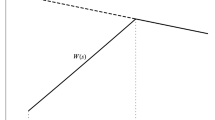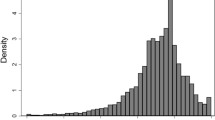Abstract
We analyze the provision of informal general training in a frictional labor market in which employers cannot commit to training levels and workers cannot commit to stay. We demonstrate that employers’ training decisions are driven by both an investment motive, to improve productivity, and a compensation motive, to increase employee retention. The investment motive decreases with higher wages, while the compensation motive increases. In our calibration exercises, the former dominates, which creates a negative relationship between wages and training. Furthermore, in contrast to recent studies missing the compensation motive, lessening the search frictions raises overall training levels due to enhanced compensation motives, approaching Becker’s result for a frictionless labor market.



Similar content being viewed by others
Notes
With regard to formal training, which is easier to measure, Lynch and Black (1998) find that over 50 percent (but not all) of U.S. firms provide and pay for general training such as computer skills training and teamwork training.
Yet, Barron et al. (1997) report that there is a great deal of measurement error in on-the-job training variables survey by survey and respondent by respondent. They show that the correlations between worker and establishment measures of on-the-job training are less than 0.5, which are much lower than correlations for other variables that have been used in wage equations. Establishments report 25 percent more hours of training on average than do workers in the same questions.
For instance, in the 1994 wave of the NLSY79, just 1% of workers in the first year of a job attended formal classes or seminars, but 57% received instruction from supervisors for an average of 52 total hours and 46% received instruction from co-workers for an average of 69 hours. Granted, some portion of this informal instruction is likely specific to the job rather than general training increasing the worker’s productivity in any job. But even if three quarters of those workers received only specific training, the number of those that received informal general training would be an order of magnitude larger than that which receive formal training.
Fallick and Fleischman (2004) find that 60 percent of vacancies in the US labor market are taken by employed searchers and only 40 percent of vacancies are given to unemployed searchers. Topel and Ward (1992) also find that a typical worker holds seven jobs during the first 10 years. In addition, Sim (2012) reports that the average job duration of white male high school graduates in the U.S. is around 2 years.
Acemoglu (1997) assumes an exogenous reallocation shock rather than on-the-job search behavior.
Note that the no-borrowing assumption prevents a ‘selling the firm scheme,’ in which workers could buy the firm and thus the efficient level of training would be achieved.
Following the convention of the search literature, we introduce ‘retirement’ and normalize its value to be zero. It can also be interpreted as ‘death.’
By incorporating the piece rate sharing rule into the wage-posting framework proposed by Burdett and Mortensen (1998), Fu (2011) analyzes the interaction between training and wages. In her model, the recruiting firm commits to a fixed piece rate and training intensity in advance. We borrow and extend her model (borrowing, in particular, the fixed piece rate wage structure) to show that firm-sponsored general training based on an implicit relational contract may increase as the competitive pressure increases.
This is innocuous when dt → 0 because the high order terms converge to zero at much faster rates.
The usual arguments apply to ensure that any equilibrium offer distribution will be continuous and have no gaps.
Note that the vertical axis in Panel (a) covers from 30 to 55, which makes the workers’ value appear flat compared to the value of operating firms shown in Panel (b). But once we adjust the scale, we can see that the workers’ value is steeper.
Sim (2016) derives a (partially) consistent result by introducing an explicit wage-training contract. In this companion paper, he shows both that the market equilibrium may over-provide general training relative to the planner’s problem and that the training intensity is reinforced as search frictions are mitigated.
References
Acemoglu D (1997) Training and innovation in an imperfect labour market. Rev Econ Stud 64:445–464
Acemoglu D, Pischke J (1999) Beyond Becker: training in imperfect labour markets. Econ J 109:112–142
Barron J, Berger M, Black D (1997) How well do we measure training? J Labor Econ 15:507–528
Becker G (1964) Human capital: a theoretical and empirical analysis, with special reference to education. University of Chicago Press
Burdett K, Mortensen DT (1998) Wage differentials, equilibrium size, and unemployment. Int Econ Rev 39:257–273
Coles MG (2001) Equilibrium wage dispersion, firm size, and growth. Rev Econ Dyn 4:159–187
Fallick B, Fleischman C (2004) Employer-to-employer flow in the U.S. labor market: the complete picture of gross worker flows, manuscript
Fu C (2011) Training, search and wage dispersion. Rev Econ Dyn 14:650–666
Hall RE, Milgrom PR (2008) The limited influence of unemployment on the wage bargain. Amer Econ Rev 98:1653–74
Lentz R, Roys N (2015) Training and search on the job. University of Wisconsin-Madison, Manuscript
Loewenstein M, Spletzer J (1998) Informal training: a review of existing data and some new evidence. Bureau of Labor Statistics Working Paper 254
Lynch LM, Black SE (1998) Beyond the incidence of employer-provided training. Indus Labor Rev 52:64–81
Sanders C, Taber C (2012) Life-cycle wage growth and heterogeneous human capital. Ann Rev Econ 4:399–425
Shimer R (2005) The cyclical behavior of equilibrium unemployment and vacancies. Amer Econ Rev 95(1):25
Sim S-G (2012) Wage dynamics with private learning-by-doing and on-the-job search. University of Tokyo, Manuscript
Sim S-G (2016) On-the-job training and on-the-job search: wage-training contracts in a frictional labor market. University of Tokyo, Manuscript
Topel R, Ward M (1992) Job mobility and the careers of young men. Q J Econ 107:439–479
Acknowledgments
We are indebted to Hidehiko Ichimura, John Kennan, Rasmus Lentz, Hideo Owan, Ozkan Eren, and Chris Taber for their helpful comments and warm encouragement. Seung-Gyu Sim acknowledges financial support by the Grants-in-Aid for Scientific Research (Kakenhi No. 26780170) from the Japan Society for the Promotion of Science. All remaining errors are ours.
Author information
Authors and Affiliations
Corresponding author
Ethics declarations
Conflict of interests
The authors declare that they have no conflict of interest.
Appendix: Details of the Numerical Algorithm
Appendix: Details of the Numerical Algorithm
In this subsection, I describe an alternative way of solving the model by converting the fixed point problem in the functional space into a fixed point problem in a finite dimensional vector space.
Taking the derivative of Eqs. 14 and 17 with respect to ϕ yields
Plugging (31) into (11) yields
Equation 33 shows how \(x^{*}_{i}(\cdot )\) proceeds to achieve the first order condition. By taking the derivative of Eq. 18 with respect to ϕ, I obtain
Plugging (24), (26), and (32) into (34) yields
Equation 35 shows how F evolves with ϕ to maintain the equal profit. Consequently, the steady state equilibrium is described as follows.
-
(i) Given U n , our equilibrium selection rule, \(U_{n}=E_{n}(\underline {\phi }, 0)\), yields \(\underline {\phi }\).
-
(ii) Given \(\{U_{i}\}_{i = 1}^{n-1}\) and \(\underline {\phi }\), the initial condition \(U_{i}=E_{i}(\underline {\phi }, x^{*}_{i}(\underline {\phi }))\) together with (14) yields \(x^{*}_{i}(\underline {\phi })\), which in turn determines \(J_{i}(\underline {\phi })\) for each i using (17).
-
(iii) Given \(\{U_{i}=E_{i}(\underline {\phi }, x^{*}_{i}(\underline {\phi })), u_{i}\}_{i = 1}^{n}\), the system of the differential Eqs. 22, 31, 32, 33 and 35 with \(F(\underline {\phi })= 0\), \(\{G_{i}(\underline {\phi })= 0\}_{i = 1}^{n}\), and the initial conditions in (i) and (ii) yields \(\{E_{i}, J_{i}, x^{*}_{i}, G_{i}\}_{i = 1}^{n}\) and F.
-
(iv) The terminal condition \(F(\overline {\phi })= 1\) determines \(\overline {\phi }\).
-
(v) Given \(\{x^{*}_{i}, G_{i}\}_{i = 1}^{n}\) and \([\underline {\phi }, \overline {\phi }]\), (25) and (27) jointly restore \(\{u_{i}\}_{i = 1}^{n}\).
-
(vi) Given \(\{E_{i}, J_{i}, x^{*}_{i}, G_{i}\}_{i = 1}^{n}\) and \([\underline {\phi }, \overline {\phi }]\), (13) restores \(\{U_{i}\}_{i = 1}^{n}\).
One advantage of this alternative prescription is that it pins down the fixed point problem in a functional space into the fixed point problem in a finite dimensional vector space. In particular, if I assume n number of different types, I need to solve for the system of 4 × n differential equations in (iii). Note that \(x^{*}_{n}= 0\) reduces one equation, but F requires one more equation. From (i), (ii) and (iii), I also have 4 × n initial conditions. Thus, I just need to solve for the fixed point of \(\{U_{i}\}_{i = 1}^{n}\) in n dimensional vector space. The monotonicity condition and (12) should be checked to ensure the existence of the optimal decision. The existence of the equilibrium fixed point of \(\{U_{i}\}_{i = 1}^{n}\) is not proved analytically. Thus, the proof is replaced with the numerical examples.
Rights and permissions
About this article
Cite this article
Sim, SG., Huegerich, T. Employer Incentives for Providing Informal On-the-job Training in the Presence of On-the-job Search. J Labor Res 39, 22–40 (2018). https://doi.org/10.1007/s12122-018-9261-3
Published:
Issue Date:
DOI: https://doi.org/10.1007/s12122-018-9261-3




